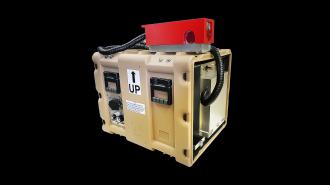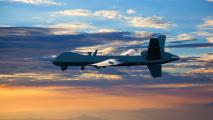This article is an installment of Future Explored, a weekly guide to world-changing technology. You can get stories like this one straight to your inbox every Thursday morning by subscribing here.
From arrows and catapults to machine guns and missiles, military arsenals have historically been built around kinetic energy weapons — basically, if you launch something at an enemy with enough force, it’ll do the desired damage.
Laser weapons, which fire beams of light rather than projectiles, could transform this paradigm — and the US military just got a “mini” version of the tech.
Laser weapons 101
High-energy laser weapons amplify and concentrate light particles into a beam that heats up whatever it’s pointed at — this heat is what damages or destroys the target.
Because the energy beam moves at the speed of light, it takes almost no time at all between when you fire a laser weapon and when it hits its target — this can make it easier to hit objects that are moving fast, such as drones or missiles.
Unlike traditional kinetic weapons, laser weapons never run out of ammo — as long as they’re connected to a power source, they can keep firing — and while the weapons themselves are expensive to build, experts predict the cost per shot could end up being as low as $1.
It’s easier to control the amount of damage inflicted by a laser weapon than a traditional one, too — simply raise or lower the power of the weapon or fire at a target for a longer or shorter period of time.
“High-energy laser systems are a better match to the threats we now face versus the threats 10 or 20 years ago.”
Iain McKinnie
Directed energy weapons (an umbrella term for weapons that fire lasers and other types of electromagnetic energy) have been on the global radar for decades, but investment in them has never been higher — more than 30 nations, including China, India, and the UK, are developing the weapons, with the US military dedicating $1 billion annually to the cause.
This surge of interest in laser weapons is largely in response to other developments shaping modern warfare.
“High-energy laser systems are a better match to the threats we now face versus the threats 10 or 20 years ago,” Iain McKinnie, director for science and technology at Raytheon Technologies, which develops laser weapons, told Military & Aerospace Electronics in 2021.
“A lot of low-end threats have become much more widely available, more proliferated and widely available,” he continued. “I’m thinking of class 1 or 2 drones that can be armed or used as targeting assets, but also rockets, artillery, or mortars.”
Current methods for dealing with those threats are expensive — Ukraine, for example, was reportedly spending $140,000 to $500,000 on each surface-to-air missile it used to take out $20,000 Russian drones in early 2023. An anti-drone laser weapon could slash the cost of defending the skies.
An increased focus on space as the next battlefield has contributed to the interest in laser weapons.
Low-end threats aren’t the only potential targets for laser weapons, though.
Progress in the creation of hypersonic weapons around the world is also incentivizing the development of faster countermeasures. The idea is that the best way to hit something moving five times faster than the speed of sound is with something that travels as fast as it’s possible to go: the speed of light.
An increased focus on space defense has contributed to the interest in laser weapons, too.
Lasers could theoretically be used to precisely damage enemy satellites, rendering them unusable without blowing them up and creating space debris that could harm everyone’s spacecraft. The systems could be fired from the ground or mounted on spacecraft and fired at satellites or incoming missiles from orbit.
The Phantom
Despite making significant progress on laser weapons, the US military has yet to figure out how to put them to use. This is partly because the weapons are large, expensive, and contain delicate components, and partly because they’re so different from any other weapons in its arsenal.
“What we don’t know yet for directed energy systems necessarily is how to fight [with] them…how to integrate kinetic and non-kinetic effectors, like directed energy, and our traditional air-defense missiles into the battlespace,” Robert Rasch, director of the Army’s Rapid Capabilities and Critical Technologies Office (RCCTO), said during the Space and Missile Defense Symposium in August.
A new laser weapon developed by military contractor Northrop Grumman could push the tech out of the prototype stage. It’s called the Phantom, and the company just delivered it to the US Department of Defense.
“Northrop Grumman is using its expertise in directed energy to deliver an extremely compact, lightweight, and efficient laser for the warfighter.”
Robert Fleming
The Phantom is about the size of a mini-fridge and weighs just 200 pounds, meaning a pair of soldiers could carry it wherever it’s needed. And because it’s nestled inside a ruggedized enclosure, it should be able to withstand harsh field conditions.
The system needs a power source to work, and at just 10 kilowatt (kW), the Phantom is far from the US’s most powerful laser weapon — Lockheed Martin delivered a 300-kW weapon in 2022.
It might not be powerful enough to take out bombers or hypersonic missiles, but the Phantom should still be capable of destroying small and mid-sized drones, and it appears to be the most deployable laser weapon available.
“By miniaturizing this advanced capability, we are expanding the reach of our technology and continuing to lead the way in high-energy lasers,” said Robert Fleming, Northrop Grumman’s VP and general manager of strategic space systems.
“Northrop Grumman is using its expertise in directed energy to deliver an extremely compact, lightweight, and efficient laser for the warfighter,” he continued.
Looking ahead
The widespread interest in laser weapons threatens to spiral into an arms race (if it isn’t one already) that increases international tension and costs a lot of money.
It also could lead to some seriously horrific combat in the future, as the same characteristics that make laser weapons alluring to militaries — fast, cheap, and powerful — make the idea of them being used offensively against people truly terrifying.
A United Nations protocol adopted in 1995 does ban signatories from using laser weapons to intentionally blind enemies, but there’s an urgent need for updated regulations, especially since at least two nations — Russia and Turkey — are reportedly already using them in battle.
“[Lasers] are gonna be on the battlefield in the future, we know it.”
Robert Rasch
For now, the US military still has a lot of questions it wants answered before it deploys laser weapons.
“First, what’s the lethality of these systems? … Number two, how reliable are they at different scales? You know, is the 10-kW as reliable as the 300? What are our reliability weak points that we need to learn and where’s the knee in that curve?” said Rasch.
The Phantom’s small size and ruggedness could make it easier to test than larger systems, and the more testing the US can do, the better equipped it’ll be to decide if and where to deploy laser weapons.
“As we collect our data over the next couple of years, I believe we’ll have the right set of data to again inform the next big decisions for the Army,” said Rasch. “[Lasers] are gonna be on the battlefield in the future, we know it. But [at] what point do we go all-in at first?”
We’d love to hear from you! If you have a comment about this article or if you have a tip for a future Freethink story, please email us at [email protected].





